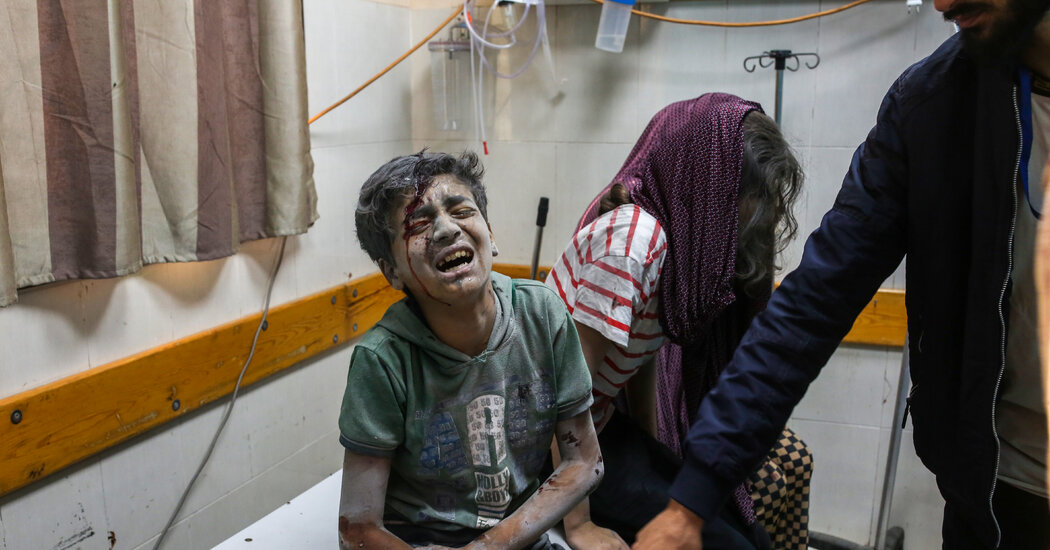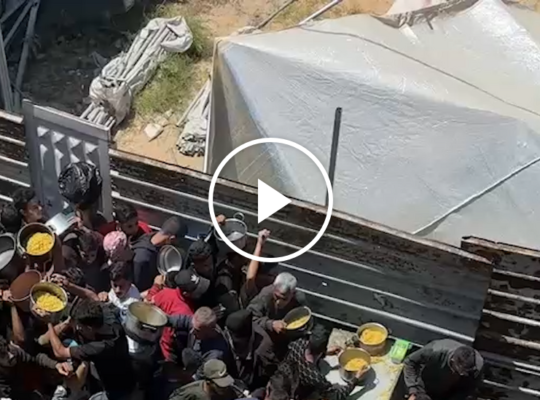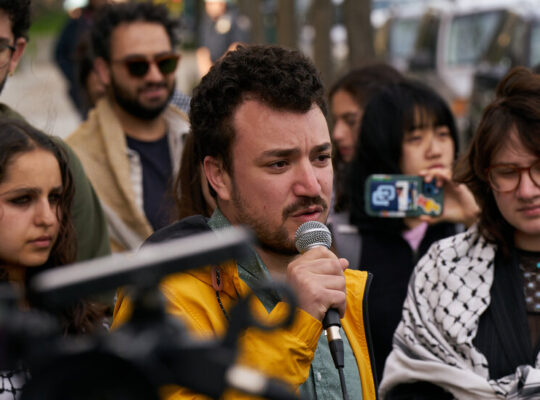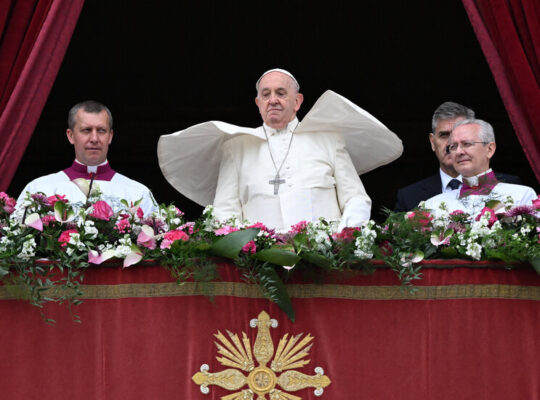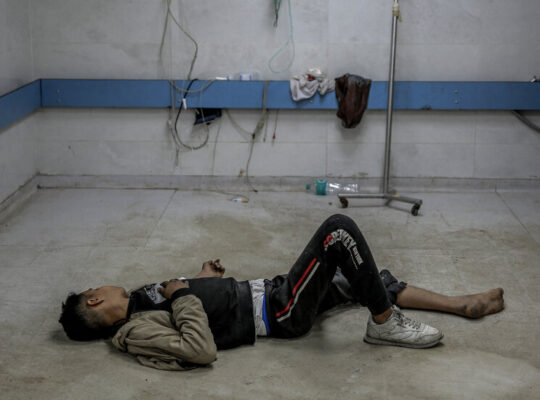People whispered that Nasser al-Astal had come undone, dazed by grief. Weeks after the Israeli airstrike that he said had crashed into his family’s home, his words came in loud, quivering spurts, darting frantically from memory to memory, from loss to loss — his wife, two of their sons and four of their daughters, all dead.
A daughter-in-law and a son-in-law, dead. His older brother and his family, dead. His first grandchild, dead, he said, his second never born: His elder son’s wife had been pregnant.
“When I look at photos of my family on my phone, I cry to myself at night,” Mr. al-Astal said in a phone interview a few weeks after his loss. “But men hide their tears, so I try to do it away from people, alone.”
All of their names were there in black and white on a list of 6,747 Palestinians who Gaza health officials said had been killed by Israeli attacks in the first 19 days of the war. No. 14: his wife, Marwa al-Astal, 48. No. 84: their granddaughter, 1, also named Marwa.
The first 88 people on the list were all from the extended al-Astal family. The next 72 were Hassounas. The next 65 al-Najjars. The next 60 al-Masrys. The next 49 al-Kurds.
Such numbers capture the magnitude of Gaza’s loss like little else: family trees dismembered, whole branches of them obliterated.
It has been almost two months since the list was released on Oct. 26, and the death toll given by Gaza’s Health Ministry has nearly tripled, approaching 20,000.
A ministry spokesman, Ashraf al-Qudra, said early last month that more than 100 people in the Astal family alone had been killed in Israeli attacks. Of 88 family members on the Oct. 26 list, 39 were identified as children and 25 as women.
Israel’s war in Gaza is killing women and children at a faster pace than in almost any other conflict in the world this century.
A few of the family’s dead were linked to Hamas, the armed Palestinian group that has ruled Gaza for 16 years and that led the Oct. 7 attacks on Israel that killed about 1,200 people, according to Israeli officials.
One family member, Hamdan al-Astal, appears to have been among those who attacked Israel. He was not on the Oct. 26 list, but Palestinian news media in Gaza reported his death the day after the assault, saying he had participated.
Another family member who survived, Yunis al-Astal, is a longtime Hamas lawmaker and firebrand sheikh who has compared Jews to bacteria and apes and said it was justifiable to “wipe them out of existence.”
Ten days after Hamdan al-Astal’s death was reported, family members buried Ramzi al-Astal, also identified in Palestinian news media as a Hamas fighter.
Relatives and local news media said he was killed when an Israeli airstrike leveled his home, along with his wife and sons Muhammad, 17, and Karim, 11. One of Ramzi’s brothers and at least five nieces and nephews, the youngest 9, were on the list.
They were just some of the thousands of civilians who have become casualties of Israel’s campaign to eradicate Hamas, family members said.
“If you want to assassinate him, assassinate him alone,” said Sami al-Astal, a distant relation, referring to Ramzi al-Astal. “If you want to assassinate him, why did you do it with his children and his family while they were at home?”
Sami al-Astal, a humanities dean at Al Aqsa University in Khan Younis, the southern Gaza city where much of his extended family lives, said some relatives supported Hamas, while others supported other Palestinian political factions, or none at all. Some were plumbers or doctors — ordinary citizens.
He was for peace, he said, and opposed killing any civilians.
Israel has moved with staggering force in its drive to wipe out Hamas, striking more than 22,000 targets in Gaza since Oct. 7, according to the military.
An estimated 20,000 to 40,000 Hamas fighters live in Gaza, an impoverished, narrow strip of land home to more than two million Palestinians.
Civilians have virtually no safe places to hide or ways to escape. The density of Gaza, where extended families often live together in multistory buildings and have crowded in even more for shelter during the war, turbocharges the potential civilian toll of many airstrikes. It also makes it difficult to separate combatants from civilians, and Israel accuses Hamas of intentionally placing members in or near hospitals, schools and homes.
Hamas is “unlawfully embedding their military assets in densely populated civilian areas, showing blatant disregard for the civilians in Gaza by using them as human shields,” said Nir Dinar, an Israeli military spokesman.
But human rights advocates, many governments and a growing number of experts say that Israel may be violating international laws against putting civilians at “excessive” risk, laws that require it to do its utmost to protect noncombatants by, for example, giving warnings or waiting until a target leaves home to strike.
Israel’s closest ally is also asking it to do more to protect civilians.
“The United States is unequivocal: International humanitarian law must be respected,” Vice President Kamala Harris said this month. “Too many innocent Palestinians have been killed.”
Even if Hamas uses civilians as human shields, those civilians are entitled to full protection under international law unless they directly participate in the fighting, said Janina Dill, an Oxford professor who studies the laws of war. Potential war crimes by Hamas cannot justify potential war crimes by Israel, she added.
“There’s no guilt by association in international law,” she said. “Even if a family is sympathetic to Hamas, voted for them, made supportive statements — none of them is a legitimate target at any time.”
Amid a growing international outcry over casualties, Israel has insisted that it is taking “all feasible measures” to protect civilians, mainly by telling them to evacuate areas with the heaviest fighting. Gazans, however, say the places they flee to are also being struck.
An Israeli military legal adviser, speaking on the condition of anonymity under military rules, argued that Israel was not violating international law. When considering any individual strike, he said, factors including Hamas’s proximity to Israel, its threat of rocket attacks on Israeli civilians and its large weapons stockpile could affect the threshold for what is considered proportionate harm to civilians.
Yet, Professor Dill said, the scale of Israel’s onslaught, along with comments by Israeli leaders that they are more focused on damage than accuracy, cast doubt on the claim that they are acting legally. Israel is deploying powerful unguided bombs in dense areas and targeting every type of building normally considered a civilian building, and therefore legally protected in most cases, she said.
Sheer probability dictated that the war would plow straight into the Astal clan. One of the largest and most influential families in southern Gaza, the Astals number in the thousands, said Sami al-Astal, who moonlights as a family historian.
Al-Astals have worked as mayors, farmers, doctors and fruit exporters. Others have been waiters and construction workers in Israel or distinguished themselves as medical researchers abroad, he said.
Strikes are battering Gaza so fast that Islam al-Astal, 47, who is distantly related to Nasser and Sami, said she barely had time to count the relatives, old classmates, friends and neighbors who have been killed, let alone mourn them.
“We need time,” she said, “time to breathe, to cry, to feel the normal things in the middle of all this ugliness.”
On Oct. 9, local news media in Gaza reported that an Israeli airstrike on a house belonging to one branch of the Astals killed at least 10 people. Two days later, the Palestinian Center for Human Rights said Israel had hit another al-Astal home.
At least four more strikes have chopped into the family tree since then, according to Palestinian news agency reports. In all, the family has been struck at least eight times over the past two months, according to relatives and those news reports.
The Israeli military said it could not address questions about specific strikes on the Astals.
Nasser al-Astal, whose wife, some children, a grandchild as well as his older brother and his brother’s family were killed in one night on Oct. 22, said he was working as a security guard at Nasser Hospital in Khan Younis around 3 a.m. when he got the call.
A relative told him that an Israeli airstrike had crushed the three-story house that he and his family shared with his brother’s family. They were coming to the hospital, alive and dead.
He said he ran to the emergency room in bare feet, he said. His colleagues tried to calm him as he rushed from one daughter to the next, daughters who had spent recent nights curled up next to him as they slept.
“When will they help us?” his eldest daughter, Hafsa, 24, gasped before she died, he said.
Hours later, after neighbors pulled them from the rubble, more bodies of family members arrived. By 3 p.m., Mr. al-Astal said, he had lowered all of them into the family cemetery.
Before the war, there were more than 100 empty plots there, Sami al-Astal said. Now, they were all full. Mr. al-Astal said he buried the women in one mass grave, the men in another.
The memories were tumbling through his mind and he could not stop talking, about his daughters and granddaughter and about Marwa, his wife of nearly 30 years. He had fallen in love with her when he was 15 and she was 13 and lived down the street, he said.
She had always known how to survive Gaza’s many trials, becoming expert in economizing when money was tight and their sons’ university bills were due. She would split their one Friday chicken between 10 people. When it became too difficult to buy bread, she made flatbread.
“She’s the kind of woman who makes you laugh and smile. She was so kind to me, so affectionate to me,” he said, recalling how she had nursed sick neighbors. “I loved her in good times and in bad times. I can’t imagine that I’ll ever marry another woman.”
The hospital where he worked was a bedlam of screaming patients, bone-tired staff and newly homeless people, but administrators found a small room for him. Though many there were weeping, they seemed to recognize that he, especially, needed somewhere private to cry.
On the Oct. 26 list, Nasser and Marwa’s oldest son, Hamza, 26, was No. 36. Their second son, Muhammad, 22, was on it, as were their daughters — Hafsa, 24, Sarah, 19, Fatima, 15, and Weam, 11.
His older brother Muhammad al-Astal and his family, along with his 3-year-old grandson, were listed, too. His 4-year-old grandson died of his wounds a few days after the list was published.
Nasser al-Astal still had his son Suleiman, 16, and his daughter Shaima, 13, who were wounded. He said he hoped Shaima would become a nurse to treat those injured in war with Israel.
And Suleiman?
“I’ll send my son to university to become a journalist,” he said, “so he can expose the crimes of the Israeli occupation.”
Isabel Kershner contributed reporting from Jerusalem.
Source link


